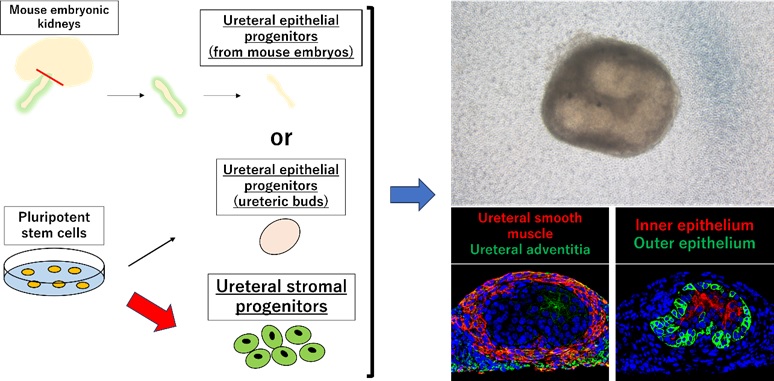
Yutaro Ibi, Koichiro Miike, Tomoko Ohmori, Chen-Leng Cai, Shunsuke Tanigawa, Ryuichi Nishinakamura. In vitro generation of a ureteral organoid from pluripotent stem cells. Nature Communications, 16: 5309, 2025.
We have successfully created ureteral tissues from pluripotent stem cells by integrating induced ureteral stromal progenitors and epithelial components derived from mouse embryos or induced ureteral epithelial progenitors. The potential of these ureteral organoids to pave the way for enhanced ureter research and, ultimately, the development of artificial kidneys for human transplantation, is a significant advancement in the field.
The kidney is a vital organ in the human body responsible for maintaining homeostasis. For the kidney to perform its function, it requires not only the kidney itself, but also the ureter, which is the outlet for the urine produced by the kidney.
Recent advances in stem cell biology have enabled the generation of artificial kidney tissues from pluripotent stem cells (PSCs). Our team led by Prof. Ryuichi Nishinakamura (Department of Kidney Development, Institute of Molecular Embryology and Genetics (IMEG), Kumamoto University) has pioneered novel methods for the induction of progenitors that comprise the kidney from PSCs. These methods have been successfully employed to generate kidneys with complex three-dimensional structures (higher-order structures) from mouse embryonic stem cells (ESCs) (Cell Stem Cell 2013 & 2017, Nat Commun 2022). However, these kidney organoids lack a ureter, which has hindered their application in transplant medicine.
The ureter is comprised of two distinct tissue compartments: the ureteral epithelium and the surrounding ureteral stroma. The development of the ureter is a result of the interactions between these components. Although several methods have been reported for inducing progenitors of the ureteral epithelium (the ureteric bud), a universally accepted method for inducing ureteral stroma remains elusive.
In this our recent work, Yutaro Ibi in the team have developed methods for inducing ureteral stromal progenitors from PSCs. They have further generated ureteral tissues by integrating these progenitors with ureteral epithelium isolated from mouse embryos or ureteric buds induced from PSCs. (Figure)
This report marks a significant milestone as the first to document the in-lab generation of such ureteral tissues. Our developments could be applied to elucidating the pathology of various diseases in the ureter. Furthermore, the successful integration of ureteral organoids with higher-order kidney organoids may pave the way for the development of kidney organoids capable of preserving the organ’s intrinsic function, including urine production and excretion. We hope to improve the quality of ureteral organoids and apply them to the generation of transplantable kidney organoids in the long run.

Figure
We developed a protocol to induce ureteral stromal progenitors from pluripotent stem cells (red arrow), and combine them with ureteral epithelial progenitors isolated from mouse embryos or induced from pluripotent stem cells to generate artificial ureteral tissues (top photo: a ureteral tissue combining ureteral stromal progenitors derived from mouse ESCs and ureteral epithelium isolated from mouse embryos). The differentiation of generated ureteral tissues was found to be analogous to that of the ureter in vivo (bottom photos: cross-section of the generated ureteral tissue).
